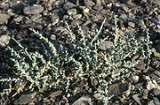
Halothamnus iranicus
Encyclopedia
Halothamnus iranicus is a species of the plant genus Halothamnus
, that is now included into the family Amaranthaceae
, (formerly Chenopodiaceae
).
3,2-4,2 mm long, longer than their bract
and bracteoles, with oblong-ovate tepals. The stigmas are tapering towards the apex. The winged fruit is 7–11 mm in diameter, their wings inserting at 1/3 of the fruit height. The fruit tube is nearly cylindrical, with narrow, sharp-edged peripheral rim and small, ovate pits.
Halothamnus
Halothamnus is a genus of the former Chenopodiaceae that is now included into the family Amaranthaceae. The scientific name means saltbush, from the Greek ἅλς "salt" and θαμνος "bush"...
, that is now included into the family Amaranthaceae
Amaranthaceae
The flowering plant family Amaranthaceae, the Amaranth family, contains about 176 genera and 2,400 species.- Description :Most of these species are herbs or subshrubs; very few are trees or climbers. Some species are succulent....
, (formerly Chenopodiaceae
Chenopodiaceae
Chenopodiaceae were a family of flowering plants, also called the Goosefoot Family. They are now included within family Amaranthaceae. The vast majority of Chenopods are weeds, and many are salt and drought tolerant. A few food crops also belong to the family: spinach, beets, chard, quinoa, and...
).
Morphology
Halothamnus iranicus is a sub-shrub up to 45 cm high and 100 cm in diameter, with blueish-green branches. It smells unpleasantly like rancid butter. The leaves are linear to triangular-ovate, and up to 11 mm long. The flowers are at 1–6 mm distance from each other,3,2-4,2 mm long, longer than their bract
Bract
In botany, a bract is a modified or specialized leaf, especially one associated with a reproductive structure such as a flower, inflorescence axis, or cone scale. Bracts are often different from foliage leaves. They may be smaller, larger, or of a different color, shape, or texture...
and bracteoles, with oblong-ovate tepals. The stigmas are tapering towards the apex. The winged fruit is 7–11 mm in diameter, their wings inserting at 1/3 of the fruit height. The fruit tube is nearly cylindrical, with narrow, sharp-edged peripheral rim and small, ovate pits.

